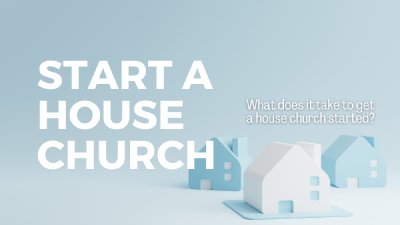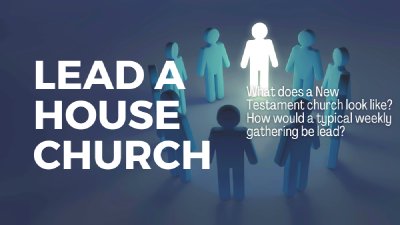PLANT
a reproducing church

Summary
The end game for a Discover Group is that its members become committed followers of Jesus Christ. When one of the members comes to Christ, it’s not uncommon for the rest of the group to follow shortly thereafter. Sometimes a whole group will commit their lives to Jesus at the same time. Regardless the process, seeing the members come to Christ is the goal of the Discovery Group. Once a person or group acknowledges faith in Jesus Christ, and a commitment to follow Him, we must obey Jesus’ command to baptize them in water as believers in Jesus Christ. Once a person is baptized as a new believer, they should also be welcomed to the family of God. This is what Acts 2:41 meant when it said the new believers were, “added.” Practically, this sometimes happens before their actual baptism since people are born again by confessing Jesus as Lord and believing in Him for their salvation (Romans 10:9-10). In this lesson we cover how to transition a Discover Group into a biblical New Testament Church as the Group members commit their lives to Jesus Christ. **What is a Church?** A church is a group of baptized believers in Jesus Christ who meet regularly to learn from God’s Word, worship God, share fellowship with Jesus and one another, nurture each other by the Holy Spirit and prayer, and leave with strength to obey God’s commands so that they reach more people with the gospel of Jesus Christ. One of the most important concepts we learn from God’s Word about a church is that it’s meant to be “a family.” ***1 John 3:1 (NIV)** “See what great love the Father has lavished on us, that we should be called children of God! And that is what we are! …”* Unlike our discussion about Persons of Peace, Discover Groups, etc., “church” is where the “FAM” of BFAM kicks in. As believers, we are children of God, and brothers and sisters of one another. Every church gathering—large or small—is a part of God’s family, so God wants us to treat each other as family. This is, therefore, an important part of The BFAM Strategy; to “Be Family.” Eight characteristics that makes a BFAM church different: 1. It treats church members like family, not like attendees. 2. It focuses on God’s word instead of a gifted teacher/leader. 3. It relies on the power of the Holy Spirit more than human energy. 4. It equips saints to do the work of ministry, not to sit in church. 5. It prioritizes obedience above knowledge. 6. It decentralized leadership instead of centralizing it. 7. It prioritizes the development of individuals, not building crowds. 8. It encourages people to go make disciples, not just to come be one. ____________________________________________________________________ Copyright © Solid Lives, 2021 All rights reserved.


Start a Church
Once the members of the group confess their faith in Christ, they should be baptized in water, celebrated, and welcomed into the family of God. At this point, the Discover Group should begin being transitioned into a New Testament church. Like with a caterpillar to a butterfly, this is a major transformation. You’re taking something that was designed for unbelievers, a Discover Group, and transforming it into something designed for believers, a Church. This doesn’t—and shouldn’t—happen overnight. Imagine how the new believers would feel if you made the change too fast. Their lives have just been changed through the Discover Group, and now they find out you want to cancel the Group and do something different that they’re not familiar with. Two things are important to begin the transition process: First, the group should understand that this transition is necessary and part of God’s plan. And second, the right Church Leader must be chosen. The leader is often the same leader that led the Discover Group, but sometimes a new leader has become obvious who is better suited and/or able to lead the new church. The conversation and process of determining who the Church Leader is should be gentle and gracious, not forced or rushed. It may take weeks to finalize the decision. Once the leader is determined, the new church members will know who will be leading them and the coach will know who to coach and mentor going forward. If it is a new leader, we should make sure not to break relationship with the former leader. Once everyone is aware that a transition process has begun and who the leader is, the Coach will regularly meet with the new Church Leader to guide him or her through the transition. Rather than injecting an extra-biblical strategy, the Coach should continue to use God’s Word as the ministry manual so that the Church Leader’s confidence is in God and not the Coach. Week by week the Coach and Church Leader will meet to discuss the church’s progress and to determine if it is time to make another change. It could be that the only initial change is the introduction of prayer. Instead of asking what each person is thankful for, the leader could say, “Let’s take time to express what we’re thankful for to God,” and then model what that sounds like. Then, after a couple of weeks, the leader may add a song of praise or worship. And, maybe after a couple of weeks, another song, and then another. As these become comfortable and meaningful, verse-by-verse teaching through a book of the Bible could be introduced. Then, after a time, “Walking with God” discipleship (we’ll talk about that in the next lesson). There is no perfect sequence or introduction schedule. All groups are different, but the point is that the new believers continue to grow spiritually and desire to continue meeting with their brothers and sisters at church. As with all things, be led by the Holy Spirit, and work closely with the Church Leader to make changes at a good pace. ____________________________________________________________________ Copyright © Solid Lives, 2021 All rights reserved.


Lead a Church
**Now let’s talk about how to lead a church.** Eight characteristics of a BFAM Church: 1. It treats church members like family, not like attendees. 2. It focuses on God’s word instead of a gifted teacher/leader. 3. It relies on the power of the Holy Spirit more than human energy. 4. It equips saints to do the work of ministry, not to sit in church. 5. It prioritizes obedience above knowledge. 6. It decentralized leadership instead of centralizing it. 7. It prioritizes the development of individuals, not building crowds. 8. It encourages people to go make disciples, not just to come be one. Once a Discover Group is fully transitioned into a New Testament church, it should generally include: **Exhortation** – a time when we engage in specific conversation about how each of us are doing, and how well we’re obeying what Jesus commissioned us to do. Here are five questions we ask each person: 1. **Thanksgiving:** What are you thankful for, or concerned about? 2. **Walks With God:** Are you on a “Walk” with God? How many steps did you take this week? What did you hear and what will you do differently? 3. **Prayer Walking:** Did go Prayer Walking, meet a Person of Peace or start a Discover Group this week? 4. **Prayer & Help:** How can we pray for or help you or someone you know? **Prayer and Ministry** – a time to pray for the needs of one another, to pray for needs outside the church, and to pray for direction, power and more laborers to be sent into the harvest. Allow various members to minister as the Holy Spirit leads them. **Worship** – a time to give thanks, worship and speak praise to God. This can happen through speaking, singing and other scriptural expressions. **Communion** – a time (at least monthly) to share the Lord’s Supper and focus on Jesus and what He has done for us. Along with thanksgiving, we receive the purchased benefits by faith and commit ourselves to love others as Jesus loved us. **Offering** – a time to worship the Lord with our tithes and offerings. A brief introduction and scriptural exhortation is shared followed by prayer and giving. No physical offerings are collected in church. Giving can be done electronically or by mail (or when close enough by dropping it off to a campus or ministry office). All general fund giving, such as tithes and general offerings, will be used to advance Operation BFAM through whatever branch your church is a part of. 100% of all designated giving (i.e. missions giving) will be used toward the specific ministry stated. **Teaching** – a time to focus on God’s Word to allow Him to speak to us, both as individuals and as a church. We study verse-by-verse through books of the Bible beginning with John, Acts and Romans. Among other things, John teaches us about the Person of Jesus Christ, Acts teaches us about the Holy Spirit and the Church, and Romans teaches us the doctrines of salvation through Jesus. The teaching time is designed to begin with insightful, well-studied teaching about what the verses say and mean, and then to use the collaborative approach of Discover Groups to discuss how they apply to our lives. -**Preparation** – the teacher will prepare to teach by studying and answering three questions about the verse(s) being studied (see “How to Teach Verse by Verse” on the BFAM App under #5 “PLANT”): 1. What does it say? 2. What does it mean? 3. What does it mean to me? -**Live Teaching** – After announcing the book and chapter being studied, the teacher will lead the group in prayer and use the following four-question format: 1. What does it say? (taught by teacher) 2. What does it mean? (taught by teacher) 3. What does it mean to us? (group discussion + teacher’s application) 4. How will I respond in faith to this truth? (encourage each person to discern what the Holy Spirit is leading them to do, and if possible, to share it with the group) 1. Make one main point. 2. Watch for the truth or promise that moves your heart. This is likely the truth that will move their heart as well. 3. As people are responding, guide the flow of discussion. Sometimes one person will be caught up in what they are saying and take too much time. Watch for them to take a breath, and kindly take back the discussion. **Response** – a time for us to discuss and respond to what God taught us, and to commit ourselves to obey. **Fellowship** – a time for meaningful conversation with one another to be encouraged and strengthened as believers. **Sample Church Gathering** -Exhortation, Prayer and Ministry – 25 minutes -Worship (Communion) – 20 minutes -Giving – 3 minutes -Teaching and Response – 30 minutes -Fellowship (after service) ____________________________________________________________________ Copyright © Solid Lives, 2021 All rights reserved.

Story
____________________________________________________________________ Copyright © Solid Lives, 2021 All rights reserved.
